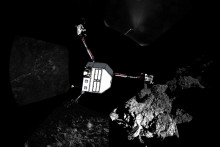Gerhard Schwehm, who has been involved in the Rosetta mission for nearly 30 years, explained all about this exciting and truly revolutionary project during his lecture, which was a part of the Week of Inspiration, organized at the University of Twente from the 24th to the 28th of November 2014.
Why do we study comets
Schwehm began his talk by explaining why studying comets is so important. ‘Comets are the only largely unchanged formations in the solar system. They contain original material from the history of the solar system, and therefore allow us to look back 4, 6 billion years ago,’ said Schwehm. By studying comets we can answer many questions such as if comets brought water and organics to Earth.
What is inside a comet
Scientists are trying to find out not only what comets look like, but also what forms their inner structure nucleus. Are comets just icy dirtballs or something more? For answering these questions, we first need samples from a comet. Those are of course difficult to obtain. ‘We decided that if we can’t get comet samples to the laboratory, we will bring a laboratory to the comet,’ stated Schwehm. And that is how Rosetta mission started.
UT´s involvement in Rosetta
Rosetta mission is managed by the ESA and it has been almost three decades in the making. Probably not many people know that even the UT has been partially involved in this historic project. Rosetta itself is a space probe, which carries a lot of innovative equipment that will help study the comet. One of these pieces of equipment is MIDAS (Micro-Imaging Dust Analysis System), which collects dust particles and is based on atomic force microscope. The coating of MIDAS was done by MESA+ Institute of the University of Twente.
Landing on a comet
Rosetta was launched in March 2004. In 2014 it positioned itself in the orbit of 67P/Churyumov-Gerasimenko comet. On the 12th of November 2014, lander – named Philae – detached itself from the orbiter in order to land on the comet.
The careful descend to the comet’s surface took 7 hours, but as soon as Philae touched the surface for the first time it bounced up again and began to float near the comet’s surface. It is not entirely certain where exactly Philae eventually landed, but it is probably positioned in a ditch without sufficient sunlight. Philae is currently on standby mode and all of its instruments are switched off. However, as the comet moves closer to the sun, the lander will most likely be able to recharge its battery and continue with more research.
A lot of new information
Thanks to Rosetta mission and its accomplishment, we got to see the first ever view of a comet’s surface. On top of that, cameras on the board of Rosetta took many breathtaking photographs during the probe’s journey to the comet. According to Dr Schwehm, Rosetta and Philae also provided a lot of other interesting data and pictures that cannot be released just yet. But even though the landing has been a great success, the mission is far from over. It will continue for about 1, 5 years and it will focus on studying the comet from close proximity.
‘It has been such an exciting and emotional accomplishment and I´m very pleased with the level of interest the public has shown,’ concluded Schwehm.







